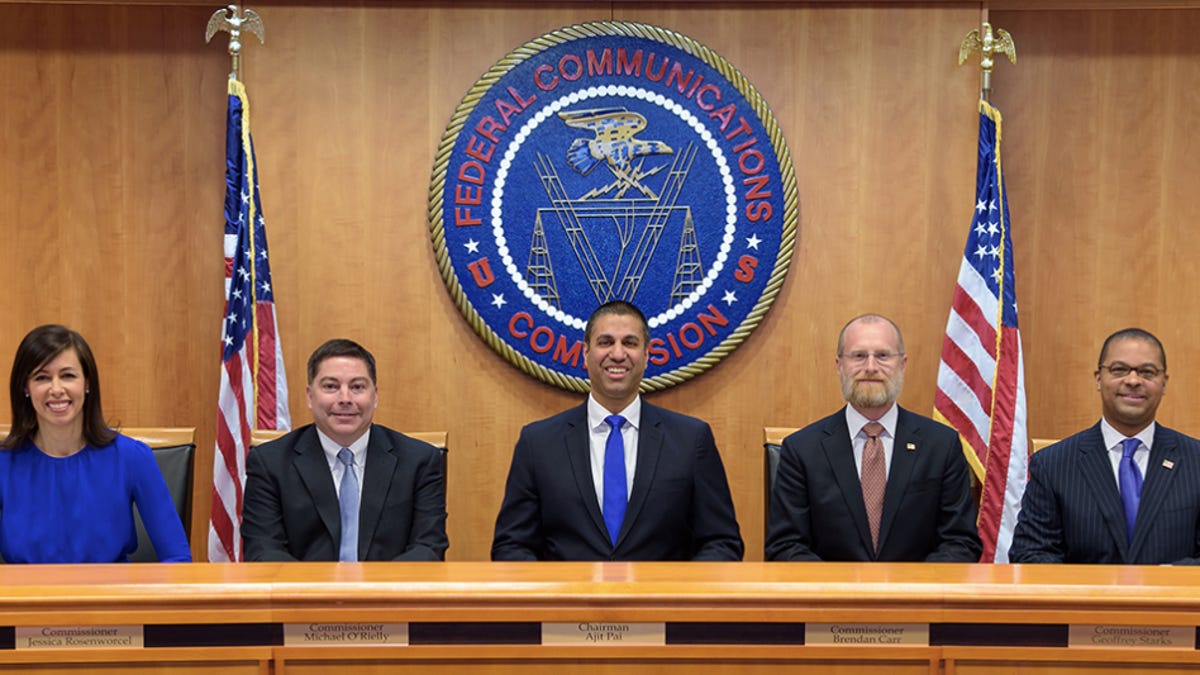FCC pushes 5G forward with upcoming midband spectrum auction
The agency votes to seek comment on rules for the upcoming auction of 3.5GHz spectrum, which'll likely be instrumental in 5G deployments.

From left: Commissioners Jessica Rosenworcel and Michael O'Rielly, Chairman Ajit Pai, Commissioners Brendan Carr and Geoffrey Starks.
The US Federal Communications Commission is moving forward on its plans to auction off a key sliver of midband spectrum licenses for 5G service. The agency voted unanimously Thursday to seek comment on bidding rules for the auction, which is set to start June 25.
The 3.5GHz spectrum, known as the Citizens Broadband Radio Service, is coveted midband spectrum that big carriers like AT&T, Verizon and T-Mobile see as valuable for 5G. But it's also spectrum that small rural fixed wireless service providers say can help them increase speeds and reach more customers.
Midband spectrum is considered valuable for 5G, because its propagation properties offer wireless carriers a good balance between coverage and speed. Up to this point, the FCC has focused much of its effort on auctioning off high-frequency spectrum, which delivers very high speed services over short distances. The FCC's 3.5GHz auction next year will be the first time the auction releases a significant amount of midband spectrum for commercial use.
FCC Chairman Ajit Pai said during the meeting that he hopes this auction will speed up the deployment of 5G service.
"Making more spectrum available for the commercial marketplace is a central plank of our 5G FAST Plan," Pai said. "The 3.5GHz band is prime midband spectrum that holds particular promise for 5G."
For years, the 3.5GHz spectrum band has been mainly allocated for use by the Department of Defense radar systems. But the FCC realized in 2015 that the spectrum was well-suited for 5G. Since then it's worked to recraft usage rules to open up the spectrum for nonfederal uses. This included establishing a novel spectrum management concept known as the Citizens Broadcast Radio Service (CBRS). This framework includes various tiers of access for the spectrum in order to allow the airwaves to be shared among different users. Some of the spectrum is unlicensed, some is allocated to the government, and other licenses will be auctioned off to wireless carriers.
A key aspect of this arrangement is the management of the spectrum by third-party Spectrum Access System (SAS) managers, which will automatically coordinate the use of the spectrum among its various types of users in real time.
"Hallelujah!," FCC Commissioner Michael O'Rielly, who's taken the lead for the agency on opening up this spectrum, said during the meeting. "With every passing day CBRS is becoming more and more a reality, and now we have an auction date."
FCC Commissioner Jessica Rosenworcel, who's been pushing the agency to open up more midband spectrum for 5G services, said she was happy to support the item. But she criticized the Republican majority on the FCC for moving too slowly.
"[I]f I had one request, it would be that we speed the day when this agency holds the 3.5GHz auction," she said. "In fact, I believe this is vitally important for both our economic and national security -- and given my druthers, I would hold this auction this year before we bring to market any more high-band spectrum, including the 37, 39, and 47GHz bands."
Funds for Puerto Rico
The FCC also voted to approve $950 million in funding to help carriers build faster and more resilient broadband networks in Puerto Rico and the US Virgin Islands, where infrastructure was devastated by Hurricanes Irma and Maria in 2017.
The FCC provided $66 million from the Universal Service Fund to assist carriers in Puerto Rico and the US Virgin Islands soon after Maria. Then in 2018, it established the Uniendo a Puerto Rico and Connect USVI funds, which in their first phases provided $64 million to assist with network restoration in the island territories.
Rosenworcel said was encouraged to see the FCC allocate more funding for the rebuilding of these networks. But she was critical of the FCC majority for its response to the disaster and for not adequately tracking where the previously allocated funds were actual spent.
"We should know with precision what was spent and where," Rosenworcel said. "I also believe we need to have a better playbook for disaster. Because the hard truth is that Hurricane Maria will not be the last extreme weather event to wreak havoc on communications infrastructure. It's time for the FCC to develop a consistent and reliable approach to ensuring the resiliency of networks in disaster."

